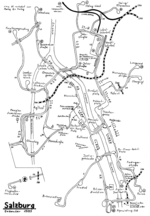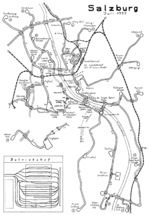Salzburg trolleybus
| Salzburg trolleybus | |
|---|---|
| Articulated trolley Solaris Trollino 18 (No. 303) | |
| Basic information | |
| Country | Austria |
| city | Salzburg |
| opening | October 1, 1940 |
| operator | Salzburg AG |
| Transport network | Salzburg Transport Association |
| Infrastructure | |
| Route length | 125 km |
| Power system | 600 V = |
| Stops | 165 |
| Depots | 1 |
| business | |
| Lines | 12 |
| vehicles | about 100 |
| statistics | |
| Passengers | > 40 million per year |
| Mileage | 5.19 million km per year |
The Salzburg trolleybus , locally mostly called the trolleybus , is one of two remaining trolleybus systems in Austria , along with the Linz trolleybus . With twelve lines , 165 stops and around 100 cars, Salzburg has the fifth largest trolleybus network in the western world after Athens / Piraeus , San Francisco , Seattle and Vancouver . It has existed since 1940 and replaced the Salzburg tram at that time .
The trolleybus transports more than 40 million passengers annually. Today it is operated by Salzburg AG, which was founded in 2000, and is integrated into the Salzburger Verkehrsverbund (SVV). In addition to the Salzburg S-Bahn , the trolleybus represents the backbone of local public transport in the city of Salzburg. The urban bus service , which began in 1927, plays only a subordinate role and is mainly operated by the Albus Salzburg transport company.
operator

While the tram was still operated by the Salzburg Railway and Tramway Company (SETG) on behalf of the City of Salzburg, it took over responsibility itself in 1940 when it switched to trolleybuses. For this purpose, the municipal transport company Salzburg was founded , which was initially only responsible for the trolleybus, but from October 1, 1948 also for the local railway lines to Hangender Stein and Lamprechtshausen . The municipal transport company in Salzburg was integrated into the new umbrella company Salzburger Stadtwerke on July 3, 1950 . Also in 1950, the city also started the municipal bus service. The exact name of the transport division was now Salzburger Stadtwerke - Verkehrsbetriebe , SStW-VB for short - from 1972 onwards in the short form Salzburger Verkehrsbetriebe , SVB for short .
The next restructuring took place in 2000, when the Salzburger Stadtwerke and the Salzburg AG für Elektrizitätswirtschaft ( SAFE ) merged to form Salzburg AG. From then on, the new sub-operation Salzburg Local Railway was responsible for the local railway lines and the likewise new sub-operation StadtBus Salzburg was responsible for the municipal trolleybus and bus traffic. In 2005, Albus finally took over all bus routes from Salzburg AG, and since then Salzburg AG has been one of the few transport companies in the world to operate trolleybuses, but not buses. In 2012 the marketing names changed again, since then the transport division has been operating under the common name of Salzburger Lokalbahnen , the trolleybus is called ObusSLB . However, the logo was renewed after four years. Since mid-2016, the trolleybuses have been running with the OBUS / SalzburgAG logo .
Lines
The twelve Salzburg trolleybus lines currently operate as follows, with some lines crossing the city limits of Salzburg:
| line | today's route | until 2003 | until 1986 | until 1972 |
| 1 | ( Kleßheim -) Europark - Fair | line 1 | line 1 | Line M |
| 2 | Walserfeld - Obergnigl | Line 2 | Line 2 | Line L |
| 3 | Salzburg South - Salzburg North | Line 51 | Line 3 | Line D |
| 4th | Mayrwies - Liefering | Line 29 | Line 4 | Line A |
| 5 | ( Grödig -) Birkensiedlung - Hauptbahnhof (- Itzling Pflanzmann) | Line 5 | Line 5 | Line F |
| 6th | Parsch - Itzling West | Line 6 | Line 6 | - |
| 7th | Salzburg South - Salzachsee | Line 49 | Line 7 | - |
| 8th | Messe - Salzburg South | Line 95 (A) | - | - |
| 9 | Europark - Justice building (- Municipal cemetery) | - | - | - |
| 10 | Sam - Kingdom of Heaven (- Walserfeld) | - | - | - |
| 12 | Josefiau - Europark | - | - | - |
| 14th | Police headquarters - Liefering | - | - | - |
Line 77, newly introduced in 1986, was closed in 2003 in favor of line 2. The new amplifier line 95, introduced in 1989, was also discontinued in 2003.
history
On October 1st, 1940 the first trolleybus drove through the streets of Salzburg. It operated as line M - for Maxglan - on the Sigmundsplatz – Maxglan route, which is now a section of line 1. Already on October 24th the extension to Makartplatz and on November 10th to the main station. On December 12, 1941, the first depot in Zaunergasse went into operation.
On February 19, 1942, the Maxglan – Lehen – main train station was opened. From then on two ring lines operated , L stood for fiefdom:
- L: Maxglan – Center – Central Station – Lehen – Maxglan
- M: Maxglan – Lehen – Hauptbahnhof – Center – Maxglan
On February 1, 1944, the third connection was Line A between Sigmundsplatz and Obergnigl, and on December 21, 1949, Line D followed as the fourth connection from the main station to the Alpine settlement . On the same day, the Alpenstrasse central garage on the new route was opened. A fifth line B led from March 1, 1951 from Sigmundsplatz to Liefering , a sixth line F - for cemetery - from November 1, 1956 from Itzling Pflanzmann to the municipal cemetery .
In 2004 trolleybus line 1 was extended by around 500 meters from the exhibition center to the Salzburgarena . As a special feature, the new terminal was initially only used for events, otherwise the overhead line in this area remained switched off. The respective status was indicated to the trolleybus drivers by means of a light signal .
On October 1, 2005, Line 1 was extended from the Europark to the EM stadium and the Kavaliershaus. On December 11, 2005, the extension of line 2 from the main train station via Mirabellplatz and Sterneckstraße to Obergnigl went into operation.
An operating line from the supply house street (line 2) via the Fürberg street to the Fading street was built in the spring of 2006 and used intensively especially during events in the city center and during the cycling events . Since then, the trolleybuses of lines 2 and 4 have been moving in and out of this route. This is the first time in the history of the Salzburg trolleybus the Kapuzinerberg will be circled. This section also formed the basis for the later electrification of Albus line 20.
The intersection Gaswerkgasse / Ignaz-Harrer-Strasse, as well as the area at the main train station around the Forum-Kaufhaus / Fanny-von-Lehnert-Strasse, was provided with additional turning and turning options by September 2006. An operating line from the State Hospital (Line 7) to Willibald-Hauthaler-Straße (Line 4), as well as an additional turning point at Makartplatz, in front of the Holy Trinity Church , have also been in operation since spring 2007 . A new turning option at the Aiglhof junction from line 4 to line 2 was created in spring 2008, as was a shoulder lane for trolleybuses in Griesgasse in the center. The latter enables the stacking and demand-oriented retrieval of trolleybuses in the center at events. When the timetable changed on December 7, 2007, line 4 from Langwied was extended beyond the city limits to Mayrwies, replacing bus line 4A.
In autumn 2008 the Salzburg municipal council decided to electrify the branch of bus line 20 to Sam / Lankessiedlung. The route follows that of line 20 from the Lankessiedlung via the S-Bahn station Salzburg-Gnigl, Fuggerstraße, Volksgarten, Hanuschplatz to the regional hospital; Via Eduard-Baumgartner-Straße and Herbert-von-Karajanplatz, the line will be led back to Hanuschplatz and to Sam. This work was completed in mid-2009, and the bus line 20 in the Sam area became the trolleybus line 10.
On July 9, 2009, lines 3 and 5 were extended by 500 meters to the new terminus at Itzling Pflanzmann. This was the first privately financed trolleybus route in Salzburg.
Since September 25, 2011, all routes on Line 1 have been running uniformly to the Salzburgarena. The overhead line was not switched off.
With the timetable change in December 2011, a new line 14 was introduced from the Schmidingerstraße stop at the Salzburg-Mitte motorway exit via Ignaz-Harrer-Straße to Saint-Julien-Straße / Rainerstraße. From there it continues - like line 3 - to Josefiau . It is an amplifier line that is only operated in the morning rush hour - that is, between 7:00 a.m. and 9:00 a.m.
On March 7, 2012, a 1.3-kilometer extension in Strubergasse went into operation. Initially, line 10, in contrast to the previous tour, ran from the Strubergasse stop through Gaswerkgase, Strubergasse, Rudolf-Biebl-Strasse and Schuhmacherstrasse. Instead of the previous terminus at Schule Lehen , it served either the terminus Salzburg Arena or Bessarabierstrasse. This improved the connection between the Stadtwerke area and the Neue Mitte Lehen with the city library.
With the timetable change on December 9, 2012, the routing of lines 8 and 10 from Hanuschplatz was changed. Instead of line 8, line 10 goes to the outlet center in Himmelreich, and line 8 goes via Neue Mitte Lehen to the exhibition center / arena or during the week to Bessarabierstraße. Line 12 was introduced with the opening of the newly built Nelböck Viaduct on December 20, 2012. This initially ran between 6 a.m. and 9 a.m. and between 3 p.m. and 7 p.m. from the Josefiau stop via Volksgarten, Sterneckstraße through the Nelböck viaduct to the regional hospital, and in the afternoon to the Europark.
In 2013, four Solaris / Ceglec 18ACs from the trolleybus company in La Chaux-de-Fonds were purchased; after a general overhaul, they were used from summer 2013. With the 2014 timetable change, line 3 was compressed to 7.5 minutes during rush hour, and at the same time, Itzling-Pflanzmann was no longer served by line 5 during rush hour.
In January 2016, the City of Salzburg and Salzburg AG decided to electrify Siezenheimer Straße and the bus line 20 running on it as line 9 over a length of 2.2 kilometers. This was ceremoniously opened on December 12, 2016, and with it some changes in the inner-city bus traffic and in the "Night Star". Line 9 runs from Monday to Saturday from Europark via Siezenheimer Straße and Aiglhof to the center of the judiciary. On school days, some morning courses go to the municipal cemetery to relieve the load on line 5. The cost of building the overhead line between Doktor-Gmelin-Straße and Hans-Schmid-Platz amounted to 2.8 million euros.
For the 2017/18 timetable change, a new route was introduced in Lehen for lines 1, 4 and 8: Line 1 has since been running on a new line from the exhibition center via Halmberggasse to route 7, which it then follows to Lehen school 4 now runs from Esshaverstraße via Strubergasse to Müllner Straße and goes along the Salzach to Hanuschplatz, while line 8 took over the previous middle section of line 4 between Esshaverstraße and Hanuschplatz via Moosstraße and Fürstenbrunnstraße. Since then, line 3 has been running to Landstrasse, where it is linked to lines 21 and 23, while line 5 is once again serving the former Plantmann terminus.
Planning
An extension of line 4 to Eugendorf or to the neighboring German town of Freilassing has been under discussion for a long time .
vehicles
Procurements over the years
Between 1986 and 1994, the Salzburg trolleybus received a total of 35 high-floor Gräf & Stift articulated cars, which from 1990 had a three-phase motor . From 2002 onwards, they were gradually taken out of service, and the last car in this series was in service in the summer of 2016. Car 219, which was parked on December 29, 2015, was after car 102 (1940–1967) the first vehicle that had been in operation for almost 27 years. Its mileage was 1,473,000 kilometers. A 36th high-floor Gräf & Stift articulated car with the number 220 was only used in 2005 from the Kapfenberg trolleybus to Salzburg, but it does not have a three-phase motor. As a further special feature, it also has a conductor's seat .
The first low-floor cars are the 23 Gräf & Stift / MAN articulated cars built between 1994 and 1997. One of them, car 240, is also a used car from Kapfenberg. Since February 2013, trolleybus 232 of this series has been the first low-floor trolleybus with a mileage of over one million kilometers. Some vehicles of this type were completely overhauled from 2013. New seat covers, LED exterior displays and more modern pantograph poles were installed on these vehicles. In addition, the entire chassis was derusted and the body refurbished. In February 2015, the joint of trolleybus 251 on the Lehener Brücke broke apart, resulting in a total write-off.
The Van Hool vehicle generation from the year of construction 2000 also only offers low-floor entrances; 13 of the 32 Van Hool vehicles also have a diesel-powered auxiliary drive as a novelty for Salzburg . On November 24, 2008, two more Van Hool articulated trolleys from the Vevey – Villeneuve trolleybus from Switzerland were added to the inventory of the Salzburg trolleybus. These are cars 2 and 15 built in 1995, they were put into service with the new road numbers 259 and 260 after a refurbishment. In addition, like the company's rail vehicles, they were painted a dark red. In the meantime, these have been taken out of service by the company due to defective electrical equipment.
The first three cars of the latest generation of vehicles, the Solaris Trollino 18 , were delivered on September 14, 2009. The twelve other vehicles 304 to 315 followed in 2010 and 2011. The new vehicles are also painted dark red and again have an auxiliary drive. Car 301 was loaned to the Eberswalde trolleybus for presentation purposes in February 2010 .
In May 2012, delivery of the so-called MetroStyle trolleybuses from Solaris began, the exterior of which is based on a tram . Car 330 was lent to Budweis in 2013 for test purposes .
Carrosserie Hess won a tender for 15 new trolleybuses, 11 of which will be delivered in autumn 2019, with the lighTram 19 BGT-N1D . The 18.75 meter long articulated vehicles with 38 seats and two wheelchair spaces are equipped with lithium titanate batteries with a capacity of 64.3 kWh. This means they can also run on routes without overhead lines. The framework agreement includes a further 35 vehicles, including 24.7 meter long double articulated trolleybuses of the lighTram 25 type .
Table of former vehicles
| Numbers | piece | Manufacturer | Type | Art | Use from | Use up | Remarks | |
|---|---|---|---|---|---|---|---|---|
| 101-110 | 10 | MAN / Schumann | MPE I | solo | 1940 | 1967 | 102 to date the longest scheduled trolleybus in Salzburg (1940-1967) | |
| 114-117 | 4th | VETRA | CS 60 | solo | 1941 | 1943 | ||
| 111-117 | 10 | MAN / Schumann | MPE II | solo | 1942 | 1966 | ||
| 121-126 | 6th | MAN / Gräf & Stift | EO I | solo | 1948 | 1974 | From January 1, 1965 111–116 | |
| 127-130 | 4th | MAN / Gräf & Stift | EO II | solo | (1950) 1956 | 1970 | From January 1, 1965 117–120 | |
| 131-133 | 3 | Uerdingen / Henschel | ÜHIIIs | solo | 1956 | 1976 | From January 1, 1965 121–123 | |
| 134-135, 143-145 |
5 | Henschel | HS 160 OSL-G | joint | 1961 | 1979 | From January 1, 1965 124–128 | |
| 136-142 | 7th | Graf & Stift | GEO II | joint | 1961 | 1980 | From January 1, 1965 129–135 | |
| 146-150 | 5 | Graf & Stift | GE 105/54/57 | joint | 1964 | 1983 | From January 1, 1965 136–140 | |
| 141-154 | 14th | Graf & Stift | GE 105/54/54 | joint | 1966 | 1989 | ||
 |
101-102 | 2 | Graf & Stift | OE 105/54 | solo | 1971 | 1986 | |
| 103-112 | 10 | Graf & Stift | OE 110/54/2 | solo | 1971 | 1990 | ||
 |
113-123 | 11 | Graf & Stift | OE 110/54 / A | solo | 1975 | 1993 | |
 |
155-160 | 6th | Graf & Stift | GE 110/54/57 / A | joint | 1976 | 1992 | |
| 161 | 1 | Graf & Stift | GE 150 M 16 | joint | 1979 | 1993 | Three-phase drive , with battery emergency drive | |
| 129-147, 162-177 |
35 | Graf & Stift | GE 110 M 16 | joint | 1980 | 2002 | 136-139 and 162-173 with battery emergency service | |
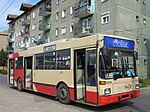 |
101-106 | 6th | Graf & Stift | OE 112 M 11 | solo | 1986 | 2002 | |
 |
107-108, 110 |
3 | Steyr | STS 11 HU | solo | 1989 | 2003 | |
| 111-114 | 4th | Steyr | STS 11 HU 140 | solo | 1990 | 2003 | ||
 |
179-188, 200-214, 218-219, 221-228 |
35 | Graf & Stift | GE 112 M 16 | joint | 1986 | 2016 | Retirement from 2002 |
 |
230, 235, 237-238, 240, 249, 251-252 |
8th | Gräf & Stift / MAN | NGT 204 M 16 | joint | 1994 | Sister vehicles to this day | Retirement from 2015, 240 formerly Kapfenberg 35 trolleybuses, from 2005 onwards, 251 dismantled and scrapped after swivel joint damage |
 |
259-260 | 2 | Van Hool | AG 300 T | joint | 2008 | 2014 | formerly VMCV 2 and 15, auxiliary drive, without automatic rod pull-off, first decommissioned low-floor wagon, 260 was scrapped, 259 was handed over to the Salzburg fire brigade school as a training object |
Some of the wagons decommissioned in Salzburg were given to other companies. They went to the former Kapfenberg trolleybus and to Germany ( Eberswalde ), Lithuania ( Vilnius ), Romania ( Mediaș , Timișoara and Vaslui ), Russia ( Perm and Rybinsk ), Serbia ( Belgrade ) and Ukraine ( Ivano-Frankivsk ).
Until 1975 the trolleybuses also ran with trailers . Salzburg was the last Austrian trolleybus network in which this type of operation could be found. There were four different series available; they came from Gräf & Stift (type OA I), Kässbohrer (without type designation), Lohner (type OM 5/1) and Schumann (without type designation).
Current inventory table
| Numbers | piece | Manufacturer | Electrics | Years of construction | Type | Low floor | Auxiliary drive | Remarks | |
|---|---|---|---|---|---|---|---|---|---|
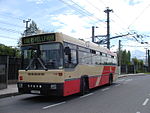 |
109 | 1 | Steyr | Box | 1989 | STS 11 HU | No | No | since 2003 museum car owned by Pro Obus Salzburg e. V., temporarily in planned operation |
 |
178 | 1 | Graf & Stift | Box | 1985 | GE 110 M 16 | No | No | since 2005 museum car owned by Pro Obus Salzburg e. V., temporarily in planned operation |
 |
220 | 1 | Graf & Stift | Box | 1989 | GE 112 M 16 | No | No | Formerly Kapfenberg 25 trolleybus, in stock since 2005, with a conductor's seat , since 2014 a museum car owned by Pro Obus Salzburg e. V., temporarily in planned operation |
 |
229, 232, 233, 236, 241, 244, 245, 247, 250 |
9 | Gräf & Stift / MAN | Box | 1994-1997 | NGT 204 M 16 | yes, except on door 3 | No | |
 |
261-271, 273-290 | 29 | Van Hool | Box | 2000-2005 | AG 300 T | Yes | yes: 261, 279–290 no: 262–278 |
|
 |
301-315 | 15th | Solaris | Cegelec | 2009-2010 | Trollino 18 | Yes | Yes | |
| 316-319 | 4th | Solaris | Cegelec | 2005 | Trollino 18 | Yes | Yes | Formerly trolleybus La Chaux-de-Fonds 141–144, in existence since 2013 | |
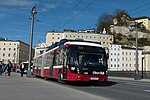 |
321-371 | 51 | Solaris | Cegelec | 2012: 321–330 2013: 331 2014: 332 2015: 333–344 2016: 345–362 2017: 363–366 2018: 367–371 |
Trollino 18 MetroStyle | Yes | yes, from 345 with battery instead of auxiliary diesel | |
 |
401-415 | 15th | Hess | 2019: 401-411 2020: 412-415 |
lighTram 19 BGT-N1D | Yes | yes, with battery |
Technical data current stock
| Type | Length in m | Width in m | Empty weight in t | Power in kW | v / max | Seats | Standing room |
|---|---|---|---|---|---|---|---|
| STS 11 HU | 11.9 | 2.5 | 10.56 | 110 | 60 km / h | 26th | 66 |
| GE 110 M 16 | 16.5 | 2.5 | 13.8 | 105 | 60 km / h | 34 | 112 |
| GE 112 M 16.5 | 16.6 | 2.5 | 13.8 | 110 [2] / 147 | 60 [2] / 65 km / h | 34 | 112 |
| NGT 204 M 16 | 16.5 | 2.5 | 14.2 | 147 | 65 km / h | 31 | 102 |
| AG 300 T | 17.95 | 2.5 | 16.76 / 16.96 [1] | 155/185 [1] | 65 km / h | 29/30 | 129/98 |
| Trollino 18 | 18th | 2.55 | 18.2 | 250 | 65 km / h | 38 | 98 |
| BGT-N1D | 18.75 | 2.55 | 38 | 117 |
[1] = based on the wagons with auxiliary units
[2] = based on the direct current version
Pro Obus Salzburg e. V. and museum car
The oldest operational trolleybus in Salzburg is an ÜHIIIs from the year of construction 1957. However, this is not an original Salzburg vehicle, the car with the number 123 comes from the Solingen trolleybus (former number 40) and is on loan from English collectors. It has been in action in Salzburg since July 2007 as part of special trips, for which it is painted in Salzburg. The vehicle can also be rented privately. On the occasion of the Salzburg Festival , the ÜHIIIs is regularly on a special museum line “M” of the Pro Obus Salzburg e. V. in action.
The former Kapfenberger Wagen 35 of the type HS 160 OSL-G, which never ran according to plan in Salzburg, is currently being operated by Pro Obus Salzburg e. V. worked up. The vehicle is on loan from the Nostalgiebahnen in Carinthia and is to be given the number 134 for future use in Salzburg.
The other three operational museum vehicles with the numbers 109, 178 and 220 are still used in the regular passenger service during rush hour. On the one hand, this serves to avoid damage to the stand and, on the other hand, it can better cover demand peaks.
In addition, the Kässbohrer trailer number 31 from 1940 is being processed by the association.
literature
- Otto Holzbauer: The trolleybus system in Salzburg. In: Verkehrstechnik , Volume 22, Issue 5 (March 5, 1941), pp. 68–70.
- Otto Holzbauer: French-style trolleybuses in Salzburg. In: Verkehrstechnik , Volume 23, Issue 16 (August 20, 1942), pp. 241–243.
- Gunter Mackinger : The trolleybus in Salzburg . Kenning Verlag, Salzburg 2005, ISBN 3-933613-74-4 .
- Alois Fuchs: Salzburg's local transport . Alfred Winter publishing house, Salzburg 1996.
Web links
- Official website of the operating company Salzburg AG
- Official Facebook page of the Pro Obus Salzburg association
- Official website of the Pro Obus Salzburg association
Individual evidence
- ↑ New vehicle fleet in Salzburg at www.salzburg24.at
- ↑ Salzburg local railways: new generation of trolleybuses, new brand , message from May 22, 2012 ( Memento of the original from May 27, 2012 in the Internet Archive ) Info: The archive link was automatically inserted and not yet checked. Please check the original and archive link according to the instructions and then remove this notice.
- ↑ City-News Archive - Salzburg [AT] - J. Lehmann - 14.06.16. (No longer available online.) Archived from the original on June 19, 2016 ; accessed on June 14, 2016 . Info: The archive link was inserted automatically and has not yet been checked. Please check the original and archive link according to the instructions and then remove this notice.
- ↑ Trolleybus line 3 extended by 300 m, report from trolleymotion.com from July 13, 2009 ( memento of the original from April 18, 2018 in the Internet Archive ) Info: The archive link was inserted automatically and has not yet been checked. Please check the original and archive link according to the instructions and then remove this notice.
- ↑ Another 1.3 km more trolleybus network, report on trolleymotion.com from March 7, 2012
- ↑ Line 12 opened through Nelböck underpass, message on trolleymotion.com from December 24th, 2012 ( page no longer available , search in web archives ) Info: The link was automatically marked as defective. Please check the link according to the instructions and then remove this notice.
- ↑ First Solaris from Switzerland in use, report on trolleymotion.com from July 8, 2013 ( page no longer available , search in web archives ) Info: The link was automatically marked as defective. Please check the link according to the instructions and then remove this notice.
- ↑ When the timetable changes, line 3 will be compressed to a 7½ minute cycle, message on trolleymotion.com from December 8, 2014 ( page no longer available , search in web archives ) Info: The link was automatically marked as defective. Please check the link according to the instructions and then remove this notice.
- ↑ New trolleybus line 9 brought to Taxham, report on trolleymotion.com from February 8, 2016 ( Memento of the original from September 9, 2017 in the Internet Archive ) Info: The archive link was inserted automatically and has not yet been checked. Please check the original and archive link according to the instructions and then remove this notice.
- ↑ a b New trolleybus line 9 from December 2016. Accessed on January 29, 2016 .
- ↑ Opening of the trolleybus line 9 to Taxham, report on trolleymotion.com from December 22, 2016 ( Memento of the original from September 9, 2017 in the Internet Archive ) Info: The archive link was inserted automatically and has not yet been checked. Please check the original and archive link according to the instructions and then remove this notice.
- ↑ Timetable change on December 10, 2017. Accessed on December 24, 2017 .
- ↑ 15.3 million euros for 15 new trolleybuses Report on salzburg24.at from November 26, 2018.
- ↑ HESS wins trolleybus tender in Salzburg , press release from December 4, 2018
- ↑ Trolleybus line 5 to Grödig , Railway Austria 12/2019
Coordinates: 47 ° 46 '56.2 " N , 13 ° 2' 31.7" E




